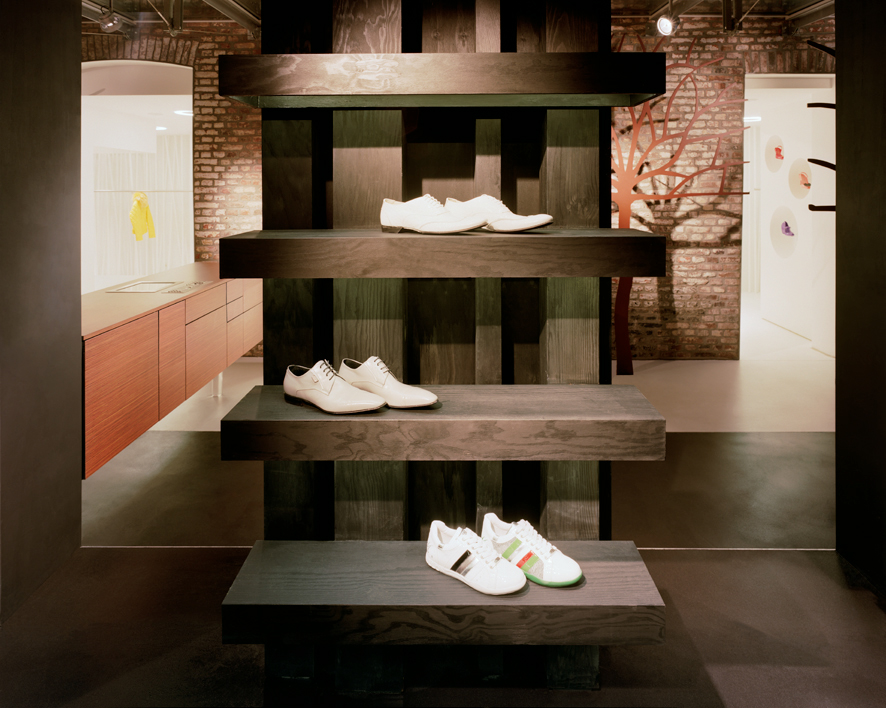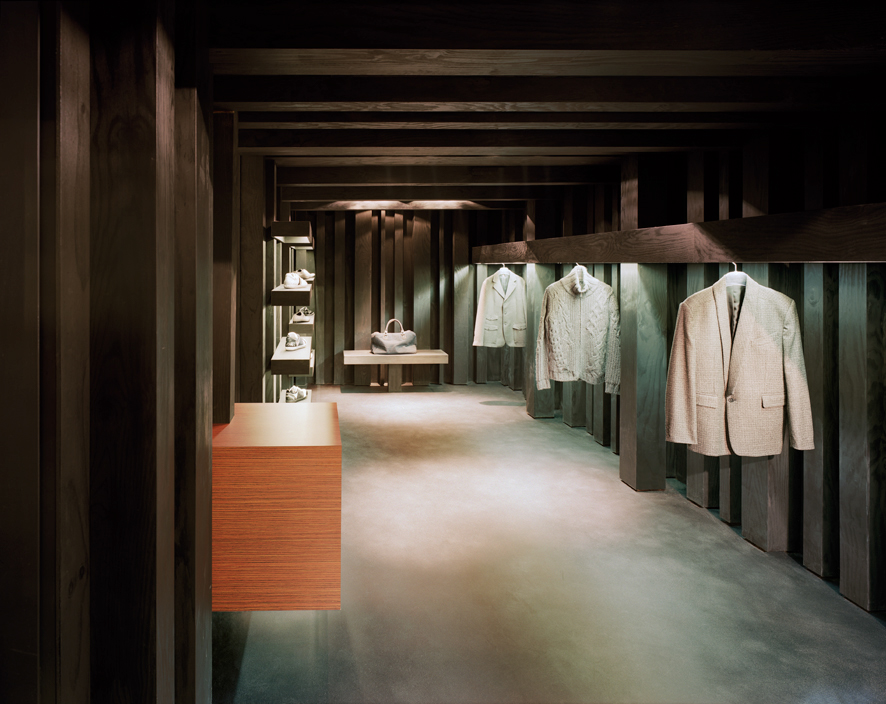Labels, Sittard, the Netherlands
Steel trees form a reference to the Garden of Eden; white refers to virginal innocence; black is for the lost paradise: a subtle feel for mythology and themystical is seen in all the work of interior designer Maurice Mentjens. He combined three small spaces and then divided them again into yin and yang. Back to the origins of fashion: “the mother of all the arts”.
Labels in Sittard offers an impressive collection of fashion brands. The existing shop soon proved to be too small, and was extended last year with the addition of a neighbouring premises. The long, narrow garden in between the buildings was given a glass roof. By breaking through windows and doors in the side walls, three interconnected spaces were created with seven passageways. Mentjens created a division between the women’s and men’s sections precisely in the middle of the central glass-roofed space, starting with the floor. One half of the floor is pure white, the other jet black: colours representing yin and yang, the feminine and the masculine. Elegant versus rugged, like the intangible, graceful world of Venus and the earthy, black smithy of Vulcan, her husband, in Roman mythology.
The connection between the spaces is made by two sales counters, half protruding into the glass-roofed space and half into the white or black areas. Thanks to an ingenious anchoring system in the wall, the blocks are almost magically suspended in the spaces. Only the very ends are subtly supported by a plexiglass foot.
The connection between the spaces is made by two sales counters, half protruding into the glass-roofed space and half into the white or black areas. Thanks to an ingenious anchoring system in the wall, the blocks are almost magically suspended in the spaces. Only the very ends are subtly supported by a plexiglass foot.
Garden of Eden
Particular eye catchers in the design are the steel trained trees in the glass-roofed space. They make handy clothes racks, but are primarily a reference to the lost paradise. The former inner courtyard immediately conjured up associations with the Garden of Eden in the mind of Maurice Mentjens. “It’s the biblical story of creation, in which Adam and Eve are free of sin in the beginning in the Garden of Eden. They only start to clothe themselves after their Fall, when they had eaten of the forbidden fruits from the tree of knowledge of good and evil, and become aware of their nakedness. They first clothed themselves with fig leaves and later with clothes made for them by God from animal skins. In this regard, you could see the design of clothes as the first creative deed in humanity and thus as the mother of all the arts.” So says an impassioned Mentjens, who sees fashion as a fully-fledged art form.
Particular eye catchers in the design are the steel trained trees in the glass-roofed space. They make handy clothes racks, but are primarily a reference to the lost paradise. The former inner courtyard immediately conjured up associations with the Garden of Eden in the mind of Maurice Mentjens. “It’s the biblical story of creation, in which Adam and Eve are free of sin in the beginning in the Garden of Eden. They only start to clothe themselves after their Fall, when they had eaten of the forbidden fruits from the tree of knowledge of good and evil, and become aware of their nakedness. They first clothed themselves with fig leaves and later with clothes made for them by God from animal skins. In this regard, you could see the design of clothes as the first creative deed in humanity and thus as the mother of all the arts.” So says an impassioned Mentjens, who sees fashion as a fully-fledged art form.



White
A virginal white fairytale-like space characterises the domain of Venus. All around are vertical and slightly inclined tubes that are reminiscent of swaying reeds. They act as supports for stainless steel clothes racks and frivolous plexiglass plateaus. Halogen lamps have been built into the ceiling in circles, alternating with circular fluorescent light fittings. Together, they depict a sky filled with geometric star systems and radiant halos. The circular forms are seen again in the striking wall features – niches in various diameters. These can be used to display bags and shoes. The supporting pins are clicked onto the steel back wall using magnets. Thanks to this ingenious system, the items on display seem to be defying gravity.
At the front end of the space is a narrow display window concealed by two changing rooms with mirror doors, which seem to double the length of the long room. The same vertical, white tubes serve as door handles. The design of the changing cubicles therefore merges into the complete picture. Next to them is a block-shaped element where shoes can be tried on. This block shape cleverly conceals the cove containing the stairway to the first floor.
A virginal white fairytale-like space characterises the domain of Venus. All around are vertical and slightly inclined tubes that are reminiscent of swaying reeds. They act as supports for stainless steel clothes racks and frivolous plexiglass plateaus. Halogen lamps have been built into the ceiling in circles, alternating with circular fluorescent light fittings. Together, they depict a sky filled with geometric star systems and radiant halos. The circular forms are seen again in the striking wall features – niches in various diameters. These can be used to display bags and shoes. The supporting pins are clicked onto the steel back wall using magnets. Thanks to this ingenious system, the items on display seem to be defying gravity.
At the front end of the space is a narrow display window concealed by two changing rooms with mirror doors, which seem to double the length of the long room. The same vertical, white tubes serve as door handles. The design of the changing cubicles therefore merges into the complete picture. Next to them is a block-shaped element where shoes can be tried on. This block shape cleverly conceals the cove containing the stairway to the first floor.


Black
Rugged, strong and linear, and covered with a heavy beam construction, the men’s section is reminiscent of a mine gallery or – more dramatically – the smithy of the mythical Vulcan. Wooden beams in various sizes have been arranged in a neat lattice. Horizontal beams are suspended along the long wall, with clothes racks underneath. On the other side of the room, the beams are used to display sweaters, shoes and accessories. The lighting is deliberately subdued to create a mysterious atmosphere. Built-in strip lights illuminate the clothing on hangers from above; halogen spotlights between the ceiling beams add a few accents.
Here, the former display window has been completely sacrificed to create changing cubicles. On the street side, there is only an LCD screen visible, showing fashion shows. As in the white section, the doors here are also camouflaged within the design of the walls. There are no individual furnishings or seats anywhere in the design. A simple, multifunctional block serves as both a seat and a table. As specific as Mentjens’ interior designs may seem at first glance, ultimately nothing distracts from the most important thing: in this case, the fashion itself.
Rugged, strong and linear, and covered with a heavy beam construction, the men’s section is reminiscent of a mine gallery or – more dramatically – the smithy of the mythical Vulcan. Wooden beams in various sizes have been arranged in a neat lattice. Horizontal beams are suspended along the long wall, with clothes racks underneath. On the other side of the room, the beams are used to display sweaters, shoes and accessories. The lighting is deliberately subdued to create a mysterious atmosphere. Built-in strip lights illuminate the clothing on hangers from above; halogen spotlights between the ceiling beams add a few accents.
Here, the former display window has been completely sacrificed to create changing cubicles. On the street side, there is only an LCD screen visible, showing fashion shows. As in the white section, the doors here are also camouflaged within the design of the walls. There are no individual furnishings or seats anywhere in the design. A simple, multifunctional block serves as both a seat and a table. As specific as Mentjens’ interior designs may seem at first glance, ultimately nothing distracts from the most important thing: in this case, the fashion itself.


images: Leon Abraas ©
